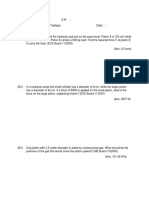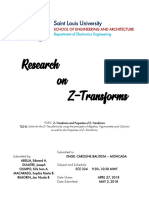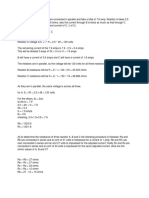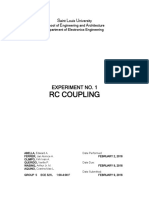0 ratings0% found this document useful (0 votes)
288 viewsABELLA, Edward A. April 16, 2018 10:30-11:30 MWF Engr. Kevin O. Obfan
The document contains 8 engineering problems related to determining stresses and torques in compound shafts made of different materials such as steel, aluminum, and bronze. The problems involve calculating maximum shear stresses, angles of twist, and diameters needed to limit stresses to permissible values when torques are applied to stepped shafts attached to rigid supports or gears.
Uploaded by
Edward Amoyen AbellaCopyright
© © All Rights Reserved
Available Formats
Download as PDF, TXT or read online on Scribd
0 ratings0% found this document useful (0 votes)
288 viewsABELLA, Edward A. April 16, 2018 10:30-11:30 MWF Engr. Kevin O. Obfan
The document contains 8 engineering problems related to determining stresses and torques in compound shafts made of different materials such as steel, aluminum, and bronze. The problems involve calculating maximum shear stresses, angles of twist, and diameters needed to limit stresses to permissible values when torques are applied to stepped shafts attached to rigid supports or gears.
Uploaded by
Edward Amoyen AbellaCopyright
© © All Rights Reserved
Available Formats
Download as PDF, TXT or read online on Scribd
You are on page 1/ 6
ABELLA, Edward A.
April 16, 2018
10:30–11:30 MWF Engr. Kevin O. Obfan
3. The steel shaft is formed by attaching a hollow shaft to a
solid shaft. Determine the maximum torque T that can be
applied to the ends of the shaft without exceeding a shear
stress of 70 MPa or an angle of twist of 2.5˚ in the 3.5-m
length. Use G = 83 GPa for steel.
4. The solid compound shaft, made of three different materials,
carries the two torques shown. (a) Calculate the maximum
shear stress in each material. (b) Find the angle of rotation of
the free end of the shaft. The shear moduli are 28 GPa for
aluminum, 83 GPa for steel, and 35 GPa for bronze.
5. The shaft carries a total torque T0 that is uniformly
distributed over its length L. Determine the angle of twist of
the shaft in terms of T0, L, G, and J.
6. The ends of the compound shaft are attached to rigid walls.
The maximum shear stress is limited to 10 000 psi for the
bronze segment AB and 14 000 psi for the steel segment
BC. Determine the diameter of each segment so that each
material is simultaneously stressed to its permissible limit
when the torque T = 16 kip · ft is applied as shown. The shear
moduli are 6 x 106 psi for bronze and 12 x 106 psi for steel.
7. The stepped solid steel shaft ABC is attached to rigid
supports at each end. Determine the diameter of segment
BC for which the maximum shear stress in both segments
will be equal when the torque T is applied at B. Note that the
lengths of both segments are given and the diameter of
segment AB is 60 mm.
8. The four rigid gears, loaded as shown in the figure are
attached to a 2-in.-diameter steel shaft. Compute the angle
of rotation of gear A relative to gear D. Use G = 12 x 106 psi
for the shaft.
You might also like
- Workout No. 3 Poisson'S Ratio, Torsion, Helical Springs, Eccentrically Riveted Connections0% (3)Workout No. 3 Poisson'S Ratio, Torsion, Helical Springs, Eccentrically Riveted Connections3 pages
- Problem Set: Strain and Thermal StressesNo ratings yetProblem Set: Strain and Thermal Stresses5 pages
- Pulleys and Tension: Engr. Princess Edynette L. PintoNo ratings yetPulleys and Tension: Engr. Princess Edynette L. Pinto16 pages
- Polytechnic University of The Philippines: ENSC 20043 Statics of Rigid Bodies Quiz 2No ratings yetPolytechnic University of The Philippines: ENSC 20043 Statics of Rigid Bodies Quiz 23 pages
- The Series Inductance-Capacitance (L-C) Circuit100% (1)The Series Inductance-Capacitance (L-C) Circuit7 pages
- Thermal Stress: Mechanics of Deformable BodiesNo ratings yetThermal Stress: Mechanics of Deformable Bodies10 pages
- Simple Stress: Analysis of Internal ForcesNo ratings yetSimple Stress: Analysis of Internal Forces12 pages
- Solution Manual For Mechanics of MateriaNo ratings yetSolution Manual For Mechanics of Materia54 pages
- Mech 3 Module 3 Unit 2 (Flanged Bolt Couplings)No ratings yetMech 3 Module 3 Unit 2 (Flanged Bolt Couplings)11 pages
- Stress: Normal Stress Shearing Stress Bearing StressNo ratings yetStress: Normal Stress Shearing Stress Bearing Stress23 pages
- Problem 03 - Bernoulli's Energy Theorem - Advance Engineering Mathematics ReviewNo ratings yetProblem 03 - Bernoulli's Energy Theorem - Advance Engineering Mathematics Review2 pages
- Module 4: Activity No. 4: W MK Q 439.6 W, T W MKNo ratings yetModule 4: Activity No. 4: W MK Q 439.6 W, T W MK3 pages
- D'alembert's Principle and Centrifugal ForceNo ratings yetD'alembert's Principle and Centrifugal Force4 pages
- Fundamentals of Deformable Bodies TorsionNo ratings yetFundamentals of Deformable Bodies Torsion10 pages
- Practice Problem No. 1 Hydraulics Fundamentals of Fluid FlowNo ratings yetPractice Problem No. 1 Hydraulics Fundamentals of Fluid Flow2 pages
- Faqs For European Customers: 1. What Are The Prices of The Tower Garden® and The Led Light Kit in Europe?No ratings yetFaqs For European Customers: 1. What Are The Prices of The Tower Garden® and The Led Light Kit in Europe?5 pages
- Institutional PAASCU ECE515FL Activity1No ratings yetInstitutional PAASCU ECE515FL Activity114 pages
- LayadCircuits Installation of Zipped Libraries v10% (1)LayadCircuits Installation of Zipped Libraries v14 pages
- E N 3 Rectifiers, Half-Wave AND Full-Wave: Aint Ouis NiversityNo ratings yetE N 3 Rectifiers, Half-Wave AND Full-Wave: Aint Ouis Niversity1 page
- Workout No. 3 Poisson'S Ratio, Torsion, Helical Springs, Eccentrically Riveted ConnectionsWorkout No. 3 Poisson'S Ratio, Torsion, Helical Springs, Eccentrically Riveted Connections
- Pulleys and Tension: Engr. Princess Edynette L. PintoPulleys and Tension: Engr. Princess Edynette L. Pinto
- Polytechnic University of The Philippines: ENSC 20043 Statics of Rigid Bodies Quiz 2Polytechnic University of The Philippines: ENSC 20043 Statics of Rigid Bodies Quiz 2
- Stress: Normal Stress Shearing Stress Bearing StressStress: Normal Stress Shearing Stress Bearing Stress
- Problem 03 - Bernoulli's Energy Theorem - Advance Engineering Mathematics ReviewProblem 03 - Bernoulli's Energy Theorem - Advance Engineering Mathematics Review
- Practice Problem No. 1 Hydraulics Fundamentals of Fluid FlowPractice Problem No. 1 Hydraulics Fundamentals of Fluid Flow
- Scientific American Supplement, No. 392, July 7, 1883From EverandScientific American Supplement, No. 392, July 7, 1883
- Faqs For European Customers: 1. What Are The Prices of The Tower Garden® and The Led Light Kit in Europe?Faqs For European Customers: 1. What Are The Prices of The Tower Garden® and The Led Light Kit in Europe?
- E N 3 Rectifiers, Half-Wave AND Full-Wave: Aint Ouis NiversityE N 3 Rectifiers, Half-Wave AND Full-Wave: Aint Ouis Niversity

















































































